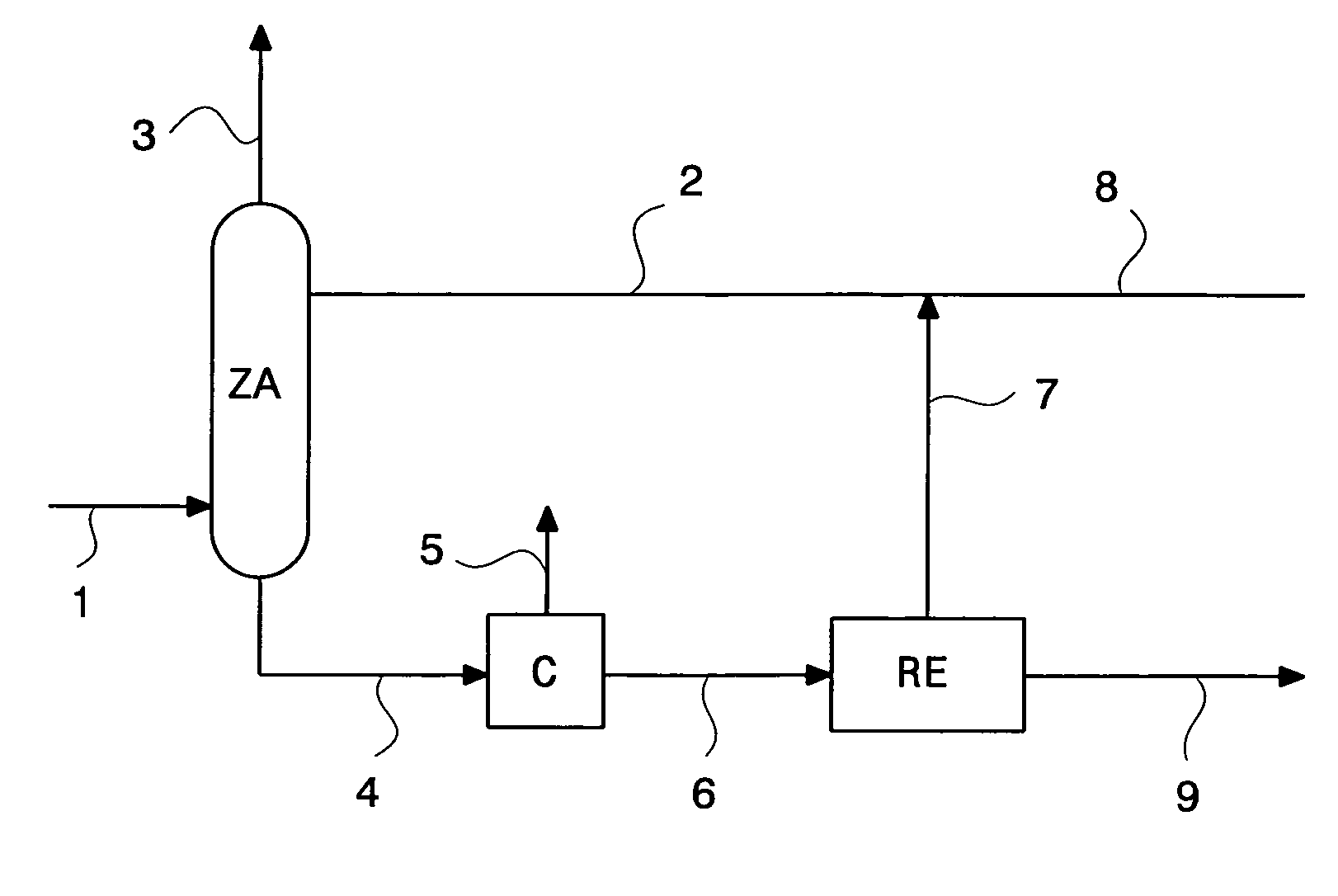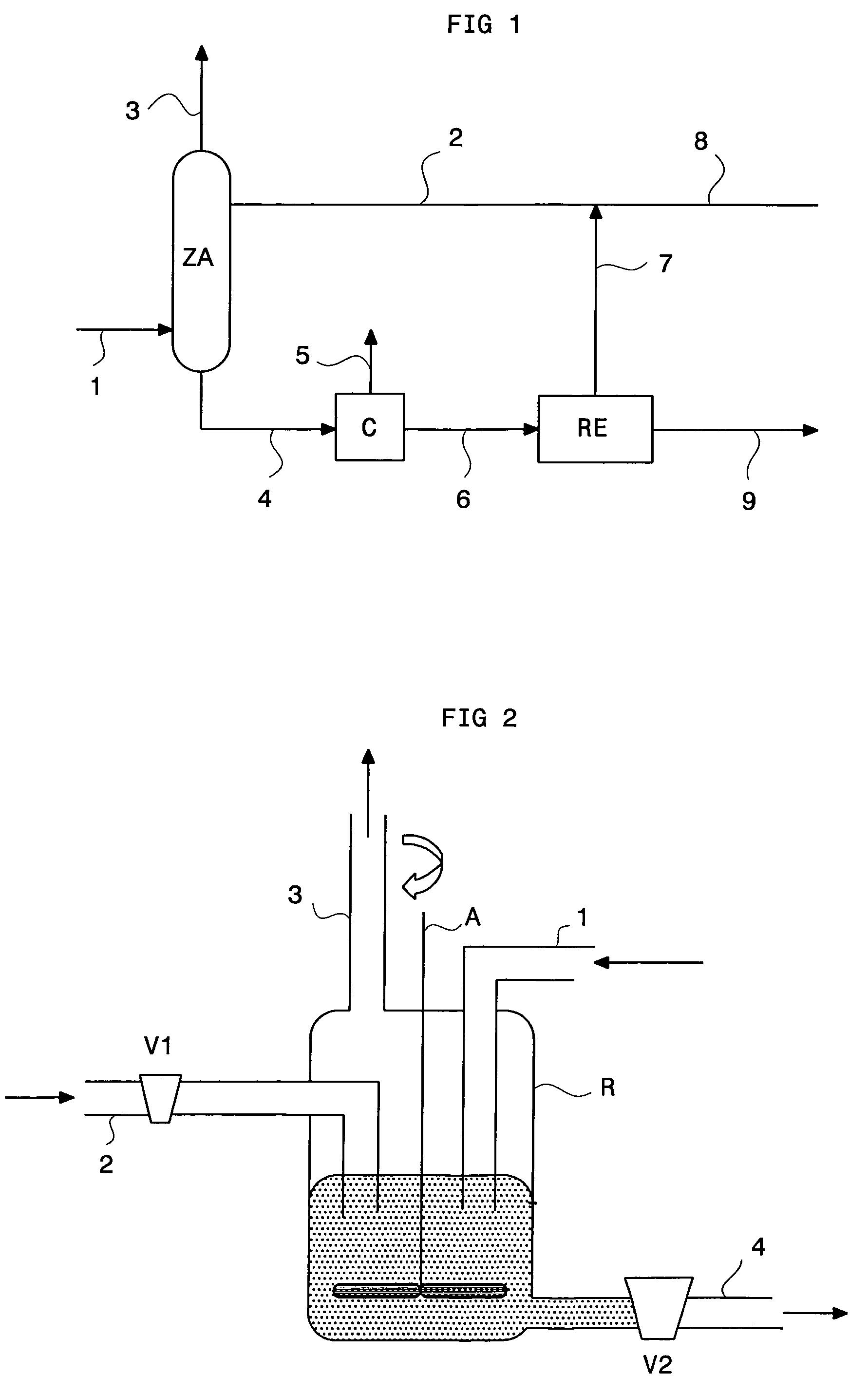Method of collecting mercaptans contained in a gaseous feed
a technology of mercaptans and gaseous feed, which is applied in the direction of gaseous fuels, separation processes, sulfur compounds, etc., can solve the problems of significant energy consumption, insufficient soluble in aqueous solution or acid, and more than four carbon atoms
- Summary
- Abstract
- Description
- Claims
- Application Information
AI Technical Summary
Benefits of technology
Problems solved by technology
Method used
Image
Examples
example 1
Elimination of Methylmercaptan (Batch System)
[0083]The experiment was carried out using a reactor as shown in FIG. 2. A feed of solvent containing an olefin, 1-dodecene, is fed into reactor R. An amount of acid catalyst, 14% by mass in relation to the solvent, is then fed into the reactor. This catalyst is a sulfonic resin marketed under reference Amberlyst 15 by the Rohm & Haas company. Stirring provides fluidization of the catalyst bed during this test. Line 1 allows to contact a gaseous effluent to be processed with the solvent. A gaseous effluent flow rate of 10 Normal 1 / h containing 2000 ppm methylmercaptan is imposed. During this experiment, olefin renewal valve V1 and sulfide-saturated solution discharge valve V2 are closed. Upon contact at ambient temperature, the mercaptan contained in the gaseous effluent is absorbed by the solvent and reacts with the 1-dodecene in the presence of the solid acid catalyst. Analysis of the gaseous effluent leaving reactor R through line 3 al...
example 2
Elimination of Methylmercaptan (Continuous System)
[0084]A second experiment was carried out with the same experimental device as in example 1, i.e. the reactor of FIG. 2. However, in example 2, renewal of the solvent is performed in reactor R. The experiment is first carried out according to the protocol described in example 1. When the mercaptan elimination rate eventually decreases as a result of the solvent saturation (below 70% elimination), makeup solvent is supplied in reactor R through line 2. Discharge through bottom valve V2 allows partial elimination of the used solvent and allows to keep the volume of solvent in reactor R constant. The supply of clean solvent allows to maintain a methylmercaptan elimination efficiency above 90%. Various operating parameters such as the gas flow rate, the solvent flow rate, the proportion of catalyst in the system were examined to test the efficiency of the method.
example 3
Regeneration of the Olefin
[0085]The reaction being balanced, example 3 was carried out to show the regenerability of the solvent. The used solvent, i.e. laden with sulfides from the methylmercaptan and dodecene reaction, is fed with the catalyst into a drum. The used solvent is obtained upon stabilization of the system described in example 1. Heating to 100° C. of the used solvent in the drum leads to invert the reaction and to reform the methylmercaptan which desorbs solvent. The temperature rise up to 120° C. allows to facilitate regeneration of the solvent. 90% of the sulfur compounds present in the solvent are eliminated in gaseous form during this test.
PUM
| Property | Measurement | Unit |
|---|---|---|
| temperature | aaaaa | aaaaa |
| temperature | aaaaa | aaaaa |
| relative pressure | aaaaa | aaaaa |
Abstract
Description
Claims
Application Information
 Login to View More
Login to View More - R&D
- Intellectual Property
- Life Sciences
- Materials
- Tech Scout
- Unparalleled Data Quality
- Higher Quality Content
- 60% Fewer Hallucinations
Browse by: Latest US Patents, China's latest patents, Technical Efficacy Thesaurus, Application Domain, Technology Topic, Popular Technical Reports.
© 2025 PatSnap. All rights reserved.Legal|Privacy policy|Modern Slavery Act Transparency Statement|Sitemap|About US| Contact US: help@patsnap.com



